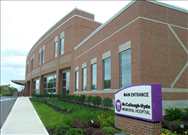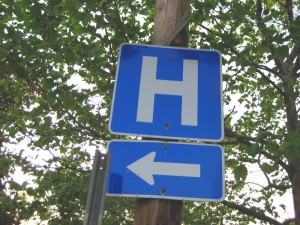History
 Major utilities are often disrupted during large-scale emergencies, including public communication systems like telephone and cellular networks. Recognizing this fact, over 30 years ago many hospitals adopted the H.E.A.R. (Hospital Emergency Administrative Radio) two-way radio system. It was implemented to provide ambulance-to-hospital and hospital-to-hospital communications on VHF high band simplex frequencies, with 155.340 MHz and 155.280 MHz being the most popular. Each hospital base station monitored the channels for the proper call sent from an incoming ambulance or from another hospital. (1)
Major utilities are often disrupted during large-scale emergencies, including public communication systems like telephone and cellular networks. Recognizing this fact, over 30 years ago many hospitals adopted the H.E.A.R. (Hospital Emergency Administrative Radio) two-way radio system. It was implemented to provide ambulance-to-hospital and hospital-to-hospital communications on VHF high band simplex frequencies, with 155.340 MHz and 155.280 MHz being the most popular. Each hospital base station monitored the channels for the proper call sent from an incoming ambulance or from another hospital. (1)
Today
The H.E.A.R. system is still in use in many parts of the nation. With the prevalence of cellular telephones, many hospitals and EMS providers have begun using them for patient reports and medical control.
The downside of the H.E.A.R. system was the nature of the technology: a single VHF frequency operating in simplex mode (transmitting from radio to radio). EMS providers and hospitals had to wait to transmit while the frequency was busy, since many hospitals shared the same channel. The audio quality was often scratchy, depending on distance and geography.
 Cellular telephone systems don’t meet public safety standards for coverage and reliability. When disaster strikes, commercial networks often fail as they become overloaded with calls. During the 2007 bridge collapse in Minneapolis, cell phone networks were often unavailable. (2) Public safety radio networks are built to keep going.
Cellular telephone systems don’t meet public safety standards for coverage and reliability. When disaster strikes, commercial networks often fail as they become overloaded with calls. During the 2007 bridge collapse in Minneapolis, cell phone networks were often unavailable. (2) Public safety radio networks are built to keep going.
In Butler County
The Butler Regional Interoperable Communications System is providing emergency hospital communications for the 21st century. Every hospital emergency department in our service area has been provided radios on BRICS with a dedicated talkgroup, allowing EMS providers to contact them directly with patient reports.
Every public safety radio in the county is able to easily access hospital talkgroups, allowing them to leverage our comprehensive in-building coverage and public safety reliability to obtain medical control.
Hospitals no longer have to wait for a clear channel while other hospitals receive reports – their talkgroup will remain clear for messages directed to their emergency department only. The audio, now digital and crisp, can be received from an EMS provider at the patient’s side. The system also provides ways for our hospitals to coordinate during disasters by providing common hospital talkgroups.
 As a pilot project, the McCullough-Hyde Memorial Hospital began using the City of Oxford’s digital 800MHz radio system in 2005 to communicate with EMS agencies. With the system’s superior in-building coverage, the hospital was provided with portable radios instead of the traditional base station. For the first time, emergency physicians were able to carry a radio around the department to hear patient reports. It has become the primary way they receive reports from EMS providers and requests for medical control.
As a pilot project, the McCullough-Hyde Memorial Hospital began using the City of Oxford’s digital 800MHz radio system in 2005 to communicate with EMS agencies. With the system’s superior in-building coverage, the hospital was provided with portable radios instead of the traditional base station. For the first time, emergency physicians were able to carry a radio around the department to hear patient reports. It has become the primary way they receive reports from EMS providers and requests for medical control.
With the countywide radio system, hospitals equipped to use the system include:
- Atrium Medical Center
- Bethesda Butler Hospital
- Children’s Hospital – Liberty Campus
- Fort Hamilton Hospital
- McCullough Hyde Memorial Hospital
- Mercy Hospital Fairfield
- West Chester Medical Center
HIPAA and Radio Communication
Click here to learn how radio communication works with the Health Insurance Portability and Accountability Act of 1996 (HIPAA).
For Hospital Users
 Each emergency department has been provided their own specific talkgroup to receive patient reports and provide medical control. The talkgroup has been programmed in the radios of every Butler County public safety agency.
Each emergency department has been provided their own specific talkgroup to receive patient reports and provide medical control. The talkgroup has been programmed in the radios of every Butler County public safety agency.
If fire and EMS agencies from neighboring counties transport to your facility and their radios are compatible with the Butler County system, we will provide them the appropriate talkgroups to communicate with you. Contact us for more information.
Download a hospital radio training presentation from 2014:
Hospital Radio Training (PDF)
Making Announcements
It is possible to make an announcement to all seven hospitals at once, using a feature called an ‘announcement talkgroup’. This may be useful for incident commanders, health officials, EMS transport coordinators or the hospitals themselves. It exists to notify hospitals in our area for something on a smaller scale or less emergent than a situation requiring activation of the regional Disaster Net.
An announcement talkgroup exists solely to share a message with its member talkgroups. Two users can not have a conversation on an announcement talkgroup, and those receiving the message (the users on the member talkgroups) can not reply back to the person making the announcement. The purpose of the announcement and any action required should be made clear in the message, including a channel to switch to if a reply is needed. Example:
“Attention all hospitals, this is an announcement from the Butler County EMA. Severe weather has resulted in a county-wide power outage and we have additional details from utility companies regarding expected restoration times. I need all hospitals to have a representative switch to the ER TALK channel for further information.”
The hospital announcement talkgroup is 09 ER ANNC and its ‘members’ are all hospital / ER talkgroups.
Sources
1) Hospitals H.E.A.R the Call for Emergency Communications – Zetron
2) Bridge Collapse Prompts Cell-Phone Overload – National Public Radio, 8/2/2007